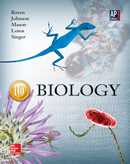1 A) Bacterium. B) Prion. C) mRNA. D) transfer vesicle. E) bacterial virus. 2 A) an envelope B) a cell wall C) a capsid D) a cell membrane E) a capsule 3 V. cholerae is converted from a harmless form to a deadly form by introduction of a toxin-producing gene from which of the following?A) Virulent virus B) Lytic bacteriophage C) Viroid D) Lysogenic bacteriophage E) Prion protein 4 A) Where it integrates in the genome. B) How the bacteriophage is assembled. C) Whether it is lytic or lysogenic. D) When it's excised from the bacterial genome. E) How rapidly the viral genome is replicated. 5 A) Mononucleosis B) Rubella C) Measles D) Yellow fever E) More than one of the above. 6 A) Double-stranded DNA B) Single-stranded DNA C) Double-stranded RNA D) Single-stranded RNA E) All of the above are found in examples of natural viruses 7 A) Because the lytic cycle amplifies the numbers of infections to all susceptible hosts in the area, all hosts will eventually be consumed. The lysogenic cycle puts a brake on this process while still retaining infectious potential. B) By integrating with the bacterial chromosome, the genetic instructions for the virus become refreshed after one or more replication events during binary fission. C) Lysogenic infection cycles don't harm their host cells, so they can produce virus particles indefinitely. D) Formation of a prophage gives the cells new abilities and survivability in an unpredictable environment, causing both the bacterium and the virus to proliferate. E) Lysogeny causes more mutations to occur in the virus, creating more variants upon which natural selection can operate. 8 A) The mutant receptor binds to and inactivates circulating HIV particles. B) The immune system in people with the mutated CCR5 receptor is inadvertently activated to recognize HIV particles, conferring resistance to infection. C) The CCR5 receptor causes a signal transduction effect which inhibits protease activity required for HIV particle assembly. D) The gene for the mutant CCR5 receptor is on the chromosome next to the gene for an enzyme that digests HIV's gp120 surface protein. E) HIV interacts with normal CCR5 surface receptors and use them to gain entry to the cell's interior. 9 A) It causes fever. B) Hemagglutinin is involved with viral construction. C) It is a surface protein which provides entry to the cell interior. D) The virus needs this enzyme to incorporate into the host cell's genome. E) It provides for a viral envelope, and acts to bypass the cell's immune defenses. 10 A) The mice would have antibodies against the infectious PrP protein. B) The mice would be completely unable to create more infectious PrP proteins. C) Because of the knockout mutation, the mice would identify the PrP protein as a foreign invader and launch a dramatic immune response. D) Without the protection of the normal PrP protein, the mouse would not have defenses against the infectious version, and thus will quickly become ill. E) All of the above are equally plausible. 11 A) The immune systems around various tissues have different strengths and weaknesses depending on the types of viruses. B) The genetic instructions differ between cell types in an individual. The viruses must capitalize on special genes that the host cells contain in order to infect them. C) Viral infection requires that proteins of the capsid can bind to specific surface proteins on the host cell. Cells of different tissues have different types of surface proteins. D) If a virus contacts an incompatible cell, it is likely to be engulfed and degraded. E) Both 1 and 3 are correct. 12 A) True B) False 13 reverse transcriptase gene be encoded in the HIV genome?A) The virus creates the reverse transcriptase protein while circulating in a victim's blood stream in order to be able to enter his or her cells. B) Reverse transcriptase is used to convert the HIV genome into double-stranded DNA in order to insert into one of the victim's chromosomes. C) Assembly of the virus is regulated by reverse transcriptase, and therefore this gene is not likely to be found in a normal, uninfected individual's genome. D) Reverse transcriptase helps assemble the glycoproteins, such as gp120, which are required for identifying and binding to host cells. E) Genetic expression of the virus is regulated by reverse transcriptase. Without it, the host cell would not be able to synthesize HIV proteins. 14 emerging viruses usually considered so threatening to public health?A) They occur randomly, through mutation, and therefore cannot be anticipated by public health systems. B) Their method of infection is airborne: that is, they emerge from the respiratory system of infected people and are therefore rapidly passed along. C) They appear and disappear quickly in populations so they can't be tracked. D) Emergent viruses become established in one species and, on rare occasions, mutate to infect another. This means the new species has no innate defense mechanisms so the disease is severe. E) They emerge from the cell membrane of an infected cell without lysing it. This means that the cell produces virus particles for the duration of its life. 15 A) It does not require close contact to infect a new host. B) It can infect many different cell types. C) It can infect many different species. D) the species that the virus can infect are spread over a large geographic distance, potentially causing pandemics. E) it can infect many cell types or species.





